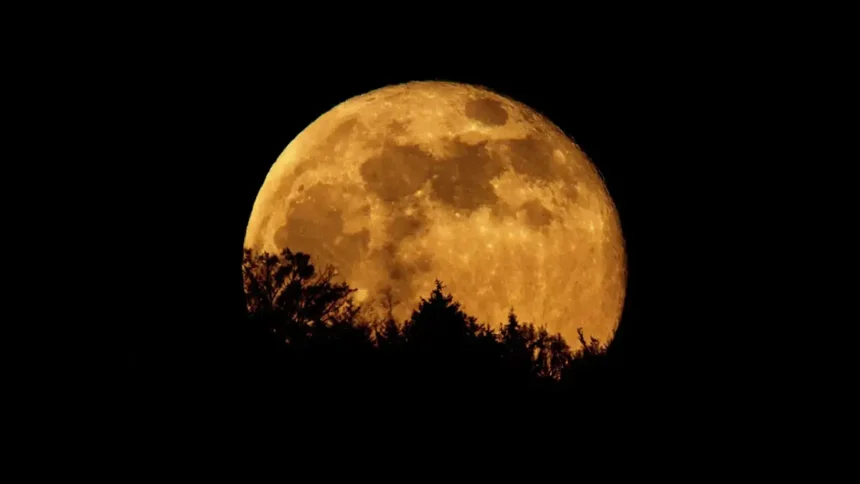Are you ready to witness a spectacular celestial event Supermoon tonight? The full moon is not just any full moon; it’s the Hunter’s Moon, and it’s also a supermoon! As we gaze up at the night sky, we have the perfect opportunity to marvel at the beauty and wonder of the cosmos. This article will answer all your questions about tonight’s supermoon, from its significance to how and when to observe it.
What is a Supermoon?
A supermoon occurs when the moon is at its closest point to Earth during its orbit, making it appear larger and brighter than usual. This phenomenon can enhance your experience, as the moon can seem up to 14% larger and 30% brighter than at its farthest distance. Tonight’s Hunter’s Moon, reaching peak illumination on October 17, 2024, is a fantastic opportunity to witness this impressive sight.
Hunter Moon: What You Need to Know
Behold: a full moon worthy of the Halloween season. The Hunter’s Moon!
— NASA (@NASA) October 16, 2024
According to the Farmer’s Almanac, this month’s full moon coincides with deer hunting season. Keep an eye on the sky for the next couple days, as the Moon will appear full through Friday morning. pic.twitter.com/6CfDPDYFBB
The Hunter Moon, named for the time when Native Americans traditionally hunted to prepare for winter, is the first full moon after the Harvest Moon. Its bright illumination helped hunters in the fields, which is how it got its name. Here are some essential facts about tonight’s moon:
- Full Moon Date: October 17, 2024
- Peak Illumination Time: 1:14 AM (EST) on October 18
- Moonrise: Approximately 7:04 PM (EST) on October 17
- Moonset: 8:06 AM (EST) on October 18
Why Is Tonight’s Supermoon Special?
Tonight’s supermoon is particularly exciting because it is closer to Earth than it will be for the next month. At a distance of 222,095 miles, it is an excellent opportunity for stargazers to enjoy a brilliant display.
Supermoon vs. Regular Full Moon: The Differences
To truly appreciate the supermoon, let’s take a closer look at how it compares to a regular full moon.
| Aspect | Regular Full Moon | Supermoon |
|---|---|---|
| Distance from Earth | Varies (up to 252,712 miles) | Closer (222,095 miles) |
| Brightness | Standard brightness | Up to 30% brighter |
| Size | Normal size | Up to 14% larger |
Observing the Supermoon
If you want to enjoy this dazzling celestial event, here are some tips for optimal viewing:
- Find a Dark Location: Choose a spot away from city lights for the best view.
- Use Binoculars or a Telescope: Although the supermoon can be stunning to the naked eye, binoculars or a telescope can enhance the experience.
- Check the Weather: Clear skies provide the best viewing conditions. Be sure to check the local weather forecast.
When Is the Next Full Moon on Halloween?
For those wondering about Halloween festivities, it’s worth noting that the next full moon on Halloween won’t occur until 2039. This year, the moon will only be 1% illuminated on Halloween, so plan accordingly if you have little trick-or-treaters!
More Celestial Events This October
Tonight’s supermoon is just one of several exciting astronomical events happening this month. Here’s a quick overview of what to look out for:
- October 14-31: Look for Comet C/2023 A3 becoming visible low in the west just after sunset.
- October 20: The moon rises near Jupiter, making for a beautiful pairing.
- October 23-24: Early risers can spot Mars high overhead in the south alongside the moon.
FAQs about the Supermoon
What causes a supermoon?
A supermoon occurs when the moon’s orbit brings it closer to Earth. The elliptical shape of the moon’s orbit means it has varying distances from Earth, making some full moons appear much larger than others.
How often do supermoons occur?
Supermoons happen several times a year. However, the exact frequency can vary based on the moon’s orbit and how close it gets to Earth. This year, October and November both feature supermoons.
Can the supermoon affect tides?
Yes, supermoons can lead to higher tides, known as “spring tides.” This effect occurs due to the moon’s increased gravitational pull when it’s closer to Earth.
Closing Thoughts
Tonight’s supermoon is a remarkable spectacle that invites all of us to step outside and admire the beauty of our universe. As you bask in the glow of the Hunter’s Moon, take a moment to appreciate the wonders of nature and our place within it.
Don’t miss out on future astronomical events and updates from USA Trends! Subscribe to our free push notifications, newsletters, and social media channels for instant updates and exciting content.
Happy moon gazing!








